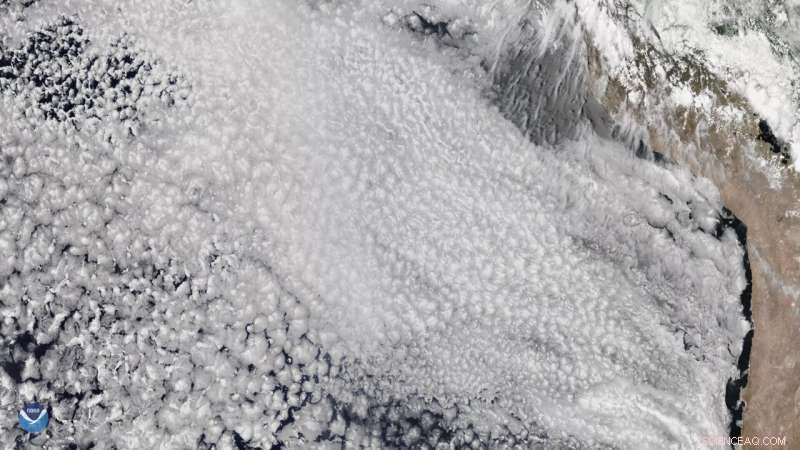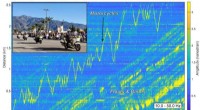
Wetenschap
Een wolkenloze toekomst? Het mysterie in het hart van klimaatvoorspellingen

Ondiepe wolken gevormd door fijne wervelingen zoals waargenomen in de natuur. Onderzoekers gebruiken geavanceerde computing om clouddynamiek met een hogere resolutie toe te voegen aan wereldwijde simulaties. Krediet:Creative commons
We horen veel over hoe klimaatverandering het land, de zee en het ijs zal veranderen. Maar hoe zal het de wolken beïnvloeden?
"Lage wolken kunnen opdrogen en krimpen als de ijskappen", zegt Michael Pritchard, hoogleraar Aardsysteemwetenschap aan UC Irvine. "Of ze kunnen dikker worden en meer reflecterend worden."
Deze twee scenario's zouden resulteren in zeer verschillende toekomstige klimaten. En dat, zegt Pritchard, is een deel van het probleem.
"Als je twee verschillende klimaatmodellen vraagt hoe de toekomst eruit zal zien als we veel meer CO2 toevoegen , krijg je twee heel verschillende antwoorden. En de belangrijkste reden hiervoor is de manier waarop wolken worden opgenomen in klimaatmodellen."
Niemand ontkent dat wolken en aërosolen - stukjes roet en stof die wolkendruppels vormen - een belangrijk onderdeel vormen van de klimaatvergelijking. Het probleem is dat deze verschijnselen zich voordoen op een lengte- en tijdschaal die de huidige modellen niet kunnen reproduceren. Ze zijn daarom via verschillende benaderingen in modellen opgenomen.
Analyses van wereldwijde klimaatmodellen laten consequent zien dat wolken de grootste bron van onzekerheid en instabiliteit vormen.
Communitycodes aanpassen
Terwijl het meest geavanceerde wereldwijde klimaatmodel van de VS moeite heeft om een wereldwijde resolutie van 4 kilometer te benaderen, schat Pritchard dat modellen een resolutie van ten minste 100 meter nodig hebben om de turbulente wervelingen op kleine schaal vast te leggen die ondiepe wolkensystemen vormen - 40 keer meer opgelost in elke richting. Volgens de wet van Moore kan het tot 2060 duren voordat de rekenkracht beschikbaar is om dit detailniveau vast te leggen.
Pritchard werkt eraan om deze flagrante kloof te dichten door het probleem van klimaatmodellering in twee delen te splitsen:een grofkorrelig planetair model met een lagere resolutie (100 km) en veel kleine patches met een resolutie van 100 tot 200 meter. De twee simulaties draaien onafhankelijk van elkaar en wisselen vervolgens om de 30 minuten gegevens uit om ervoor te zorgen dat de simulatie niet van de baan raakt en niet onrealistisch wordt.
Zijn team heeft de resultaten van deze inspanningen gerapporteerd in het Journal of Advances in Modeling Earth Systems in april 2022.
Deze klimaatsimulatiemethode, een "Multiscale Modeling Framework (MMF)" genoemd, bestaat al sinds 2000 en is al lang een optie binnen het Community Earth System Model (CESM) -model, ontwikkeld door het National Center for Atmospheric Research. Het idee beleefde de laatste tijd een renaissance bij het Department of Energy, waar onderzoekers van het Energy Exascale Earth System Model (E3SM) het naar nieuwe computationele grenzen hebben geduwd als onderdeel van het Exascale Computing Project. Pritchard's co-auteur Walter Hannah van het Lawrence Livermore National Laboratory helpt deze inspanning te leiden.
"Het model doet een eind-run rond het moeilijkste probleem:modellering van de hele planeet," legde Pritchard uit. "Het heeft duizenden kleine micromodellen die dingen vastleggen zoals realistische ondiepe wolkenformatie die alleen in zeer hoge resolutie tevoorschijn komt."
"De benadering van het Multiscale Modeling Framework is ook ideaal voor de aankomende GPU-gebaseerde exascale-computers van DOE", zegt Mark Taylor, Chief Computational Scientist voor het Energy Exascale Earth System Model (E3SM) -project van de DOE en een onderzoekswetenschapper bij Sandia National Laboratories. "Elke GPU heeft de pk's om honderden micromodellen te laten draaien en tegelijkertijd de doorvoer van het grofkorrelige planetaire model met lagere resolutie te evenaren."
Het onderzoek en de nieuwe aanpak van Pritchard worden mede mogelijk gemaakt door de door NSF gefinancierde Frontera-supercomputer in het Texas Advanced Computing Center (TACC). Pritchard, de snelste universitaire supercomputer ter wereld, kan zijn modellen op Frontera draaien op een tijd- en lengteschaal die alleen toegankelijk is op een handvol systemen in de VS en hun potentieel voor cloudmodellering testen.
"We hebben een manier ontwikkeld voor een supercomputer om het werk van het simuleren van de cloudfysica het beste te verdelen over verschillende delen van de wereld die verschillende hoeveelheden resolutie verdienen... zodat het veel sneller werkt", schreef het team.
Simulating the atmosphere in this way provides Pritchard the resolution needed to capture the physical processes and turbulent eddies involved in cloud formation. The researchers showed that the multi-model approach did not produce unwanted side effects even where patches using different cloud-resolving grid structures met.
"We were happy so see that the differences were small," he said. "This will provide new flexibility to all users of climate models who want to focus high resolution in different places."
Disentangling and reconnecting the various scales of the CESM model was one challenge that Pritchard's team overcame. Another involved reprogramming the model so it could take advantage of the ever-increasing number of processors available on modern supercomputing systems.
Pritchard and his team—UCI postdoctoral scholar Liran Peng and University of Washington research scientist Peter Blossey—tackled this by breaking the inner domains of the CESM's embedded cloud models into smaller parts that could be solved in parallel using MPI, or message passing interface—a way of exchanging messages between multiple computers running a parallel program across distributed memory—and orchestrating these calculations to use many more processors.
"Doing so seems to already provide a four-time speed-up with great efficiency. That means, I can be four times as ambitious for my cloud-resolving models," he said. "I'm really optimistic that this dream of regionalizing and MPI decomposing is leading to a totally different landscape of what's possible."
Machine learning clouds
Pritchard sees another promising approach in machine learning, which his team has been exploring since 2017. "I've been very provoked by how performantly a dumb sheet of neurons can reproduce these partial differential equations," Pritchard said.
Pritchard's research and new approach is made possible in part by the NSF-funded Frontera supercomputer at TACC. The fastest university supercomputer in the world, Pritchard can run his models on Frontera at a time and length-scale accessible only on a handful of systems in the U.S. and test their potential for cloud modeling.
In a paper submitted last fall, Pritchard, lead author Tom Beucler, of UCI, and others describe a machine learning approach that successfully predicts atmospheric conditions even in climate regimes it was not trained on, where others have struggled to do so.
This "climate invariant" model incorporates physical knowledge of climate processes into the machine learning algorithms. Their study—which used Stampede2 at TACC, Cheyenne at the National Center for Atmospheric Research, and Expanse at the San Diego Supercomputer Center—showed the machine learning method can maintain high accuracy across a wide range of climates and geographies.
"If machine learning high-resolution cloud physics ever succeeded, it would transform everything about how we do climate simulations," Pritchard said. "I'm interested in seeing how reproducibly and reliably the machine learning approach can succeed in complex settings."
Pritchard is well-positioned to do so. He is on the Executive Committee of the NSF Center for Learning the Earth with Artificial Intelligence and Physics, or LEAP—a new Science and Technology Center, funded by NSF in 2021 directed by his long-time collaborator on this topic, Professor Pierre Gentine. LEAP brings together climate and data scientists to narrow the range of uncertainty in climate modeling, providing more precise and actionable climate projections that achieve immediate societal impact.
"All of the research I've done before is what I would call 'throughput-limited.'" Pritchard said. "My job was to produce 10- to 100-year simulations. That constrained all my grid choices. However, if the goal is to produce short simulations to train machine learning models, that's a different landscape."
Pritchard hopes to soon use the results of his 50 meter embedded models to start building up a large training library. "It's a really nice dataset to do machine learning on."
But will AI mature fast enough? Time is of the essence to figure out the destiny of clouds.
"If those clouds shrink away, like ice sheets will, exposing darker surfaces, that will amplify global warming and all the hazards that come with it. But if they do the opposites of ice sheets and thicken up, which they could, that's less hazardous. Some have estimated this as a multi-trillion dollar issue for society. And this has been in question for a long time," Pritchard said.
Simulation by simulation, federally-funded supercomputers are helping Pritchard and others approach the answer to this critical question.
"I'm torn between genuine gratitude for the U.S. national computing infrastructure, which is so incredible at helping us develop and run climate models," Pritchard said, "and feeling that we need a Manhattan Project level of new federal funding and interagency coordination to actually solve this problem."
 Stijgende emissies veranderen arctische permafrost in een koolstofbron, uit onderzoek blijkt
Stijgende emissies veranderen arctische permafrost in een koolstofbron, uit onderzoek blijkt Plant een boom:Milans ambitieuze plannen om schoner te worden, groener
Plant een boom:Milans ambitieuze plannen om schoner te worden, groener Maritieme robots kunnen de voorspellingen van het Europese weer in de toekomst verbeteren
Maritieme robots kunnen de voorspellingen van het Europese weer in de toekomst verbeteren Toevalligheden beïnvloeden het begin en einde van ijstijden
Toevalligheden beïnvloeden het begin en einde van ijstijden Onderzoekers tonen pad naar emissievrije LA
Onderzoekers tonen pad naar emissievrije LA
Hoofdlijnen
- Anafase: wat gebeurt er in dit stadium van mitose en meiose?
- CRISPR-octrooioorlogen benadrukken het probleem van het verlenen van brede intellectuele eigendomsrechten voor technologie die publieke voordelen biedt
- Ongevaarlijk of dodelijk? Onderzoek naar de evolutie van E. coli
- Genen dicteren niet altijd dat jongens jongens zullen zijn
- Enzymen: wat is het? & Hoe werkt het?
- Hoe ballistische valkaakmieren zelfvernietiging voorkomen met een perfecte onderkaakboog
- Nieuwe techniek doorzoekt het genoom op genen die ziekten bestrijden
- Kunnen boerderijen maximaal produceren en toch de uitstoot van broeikasgassen verminderen?
- Gezocht:vrijwillige schutters om kudde bizons in Grand Canyon uit te dunnen (update)
- India zegt dat Chinese constructie op rivier het water vervuilt

- Nieuw vuur in Californië groeit naarmate bemanningen vooruitgang boeken bij andere branden

- Het afschaffen van subsidies voor fossiele brandstoffen zal de CO2-uitstoot niet zoveel verminderen als gehoopt

- Waar komt de aardwarmte vandaan?

- Glasvezel legt seismische handtekeningen van de rozenparade vast

 Warmere aarde kan kleinere vlinders zien die moeite hebben om te vliegen, waardoor voedselsystemen worden aangetast
Warmere aarde kan kleinere vlinders zien die moeite hebben om te vliegen, waardoor voedselsystemen worden aangetast Afghanistan heeft enorme minerale rijkdom, maar staat voor grote uitdagingen om deze aan te boren
Afghanistan heeft enorme minerale rijkdom, maar staat voor grote uitdagingen om deze aan te boren Zeewater kan de fosfor hebben geleverd die nodig is voor opkomend leven
Zeewater kan de fosfor hebben geleverd die nodig is voor opkomend leven Hoe valentie van elektronen in het periodiek systeem te berekenen
Hoe valentie van elektronen in het periodiek systeem te berekenen  Nieuwe cuprate-supergeleider kan klassieke wijsheid uitdagen
Nieuwe cuprate-supergeleider kan klassieke wijsheid uitdagen Dieren van het Abyssal Ecosysteem
Dieren van het Abyssal Ecosysteem  Studie bevestigt bijdrage van bio-energie aan mitigatie van klimaatverandering
Studie bevestigt bijdrage van bio-energie aan mitigatie van klimaatverandering Wat is Saturnus Core gemaakt van?
Wat is Saturnus Core gemaakt van?
- Elektronica
- Biologie
- Zonsverduistering
- Wiskunde
- French | Italian | Spanish | Portuguese | Swedish | German | Dutch | Danish | Norway |

-
Wetenschap © https://nl.scienceaq.com

